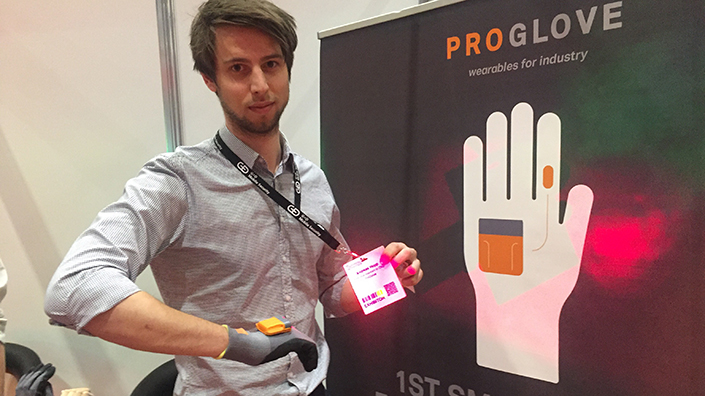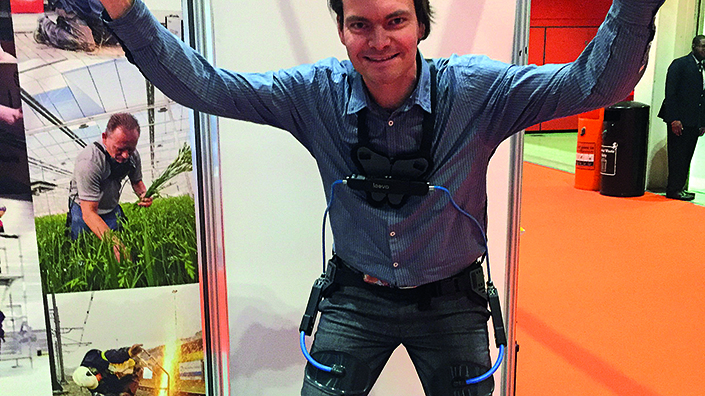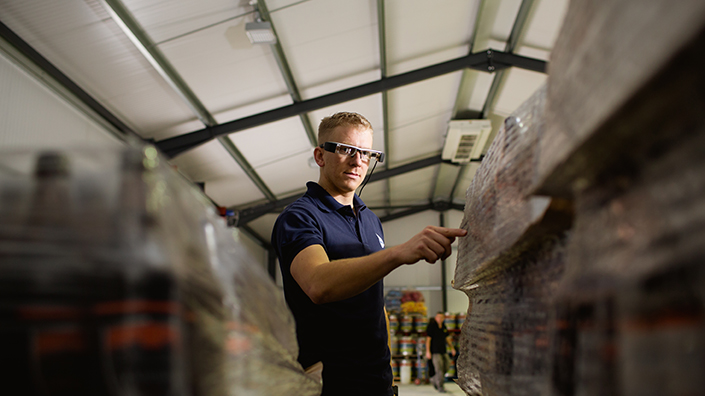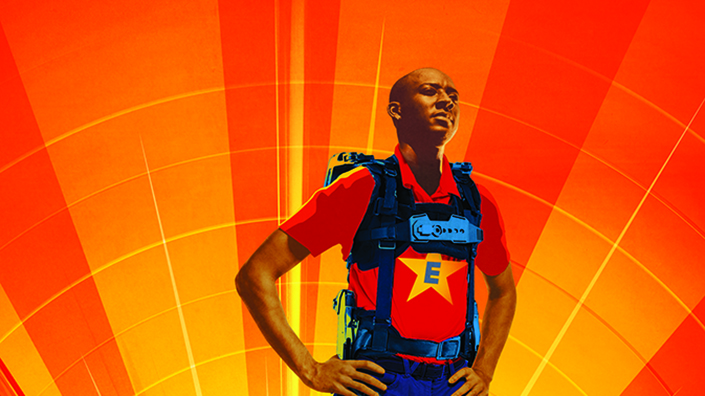Aaron Windmüller is standing in London’s ExCeL centre, one arm stuck out with his palm flat and his middle and ring finger bending back towards his wrist. Thumb, index and little finger pointing outwards, the pose looks oddly familiar. He presses a button on the wrist – but, instead of sticky, crime-fighting web, out shines a red laser.
“You can feel like Spider-Man, it’s true,” he says, grinning. ProGlove devices achieve a simple goal – replacing handheld barcode scanners to maximise factory efficiency – but manager Windmüller is not alone in using superhero rhetoric as he promotes his company at the Wearable Technology Show.
There’s the Laevo exoskeleton, which “takes away gravity” with muscle support, and the Third Eye goggle attachment that reveals heat signatures, letting users “see in the dark”.
As wearable technologies such as augmented reality mature, they are appearing in more workplaces than ever before. From nuclear submarines below the ocean waves to BMW factories, employers are asking staff to don a growing range of gloves, goggles and suits.

A ProGlove employee demonstrates one of the company's products
Developers tout the superhuman powers provided, with many claiming to make workers safer and companies more efficient. However, with the potential for widespread surveillance, employees and researchers are also concerned about privacy issues.
Companies “haven’t scratched the surface of wearable technology,” experts at the technology show claim. But, regardless of how the devices develop, they are already having an impact in the world of work.
Tucked into an unglamorous corner of ExCeL in London’s unglamorous Docklands, entrepreneurs, researchers and government bodies are nonetheless upbeat about their sector’s future. Consumer-focused companies might still search for their “killer app”, but others are aiming for positive change in industrial settings.
Dr Theodore Hughes-Riley, research fellow at Nottingham Trent University, demonstrates a sausage-fingered glove that at first glance appears similar to normal workers’ kit.
Under the surface, however, high-tech yarn monitors dangerous vibrations going into the hand. Knitted into the palm are 2mm-long sensors and accelerometers, which Hughes-Riley says can monitor the entire frequency of tools used in manual work.
Bad vibes
“Damage due to vibration is a cumulative effect,” he explains. “Over-exposure to vibration can cause musculoskeletal, pulmonary and other neurological disorders – vibration white finger is a fairly well-known issue.”
Aimed at workers using heavy equipment such as concrete breakers, grinders or hammer drills, the innocuous device replaces easily fudged time reports with accurate logs of vibration levels. It alerts workers if they approach dangerous levels of exposure.
Health is a key focus for other exhibitors, who hope to convince firms of the cumulative benefits of cladding workers in wearable tech.
“There are two main causes of back pain – first, there are people who move too little and sit behind a desk all day. We don’t solve that for them. The second is people who do too much – that we help for,” says Boudewijn ‘Bo’ Wisse, director of Laevo Exoskeletons.
“It is a huge problem. Worldwide, it is the biggest burden. In the US, for example, there are 26m people having a mean of seven days off work per year. Those are amazing numbers.”

Bo Wisse in his Laevo exoskeleton
Weighing just 2.8kg and costing roughly £2,000 per unit, Wisse’s exoskeleton is less futuristic-looking than the name suggests. Metal, plastic and textiles combine into a compact system of springs and restraints, supporting wearers every time they bend forwards.
Clicking on easily, the suit is comfortable and straightforward. Take a few steps and it barely makes its presence known, but bend forwards or crouch and it instantly provides firm support where needed.
The Laevo is hardly Iron Man’s impervious rocket-powered suit, but it does feel secure, and used over time the hope is that it could keep people strong and working for many years.
Great power
Elsewhere, companies take a more proactive approach to giving users superpowers – thankfully without the tragic accidents favoured by comic books and films.
With the Third Eye, US company RoundConcept is stretching the visible spectrum of light to let users “see heat”. Taking advantage of new, smaller, thermal sensors, the camera system clips on to smart glasses to reveal objects’ heat signatures in vibrant colour.
Aimed at search-and-rescue and environmental workers as well as maintenance or manufacturing technicians and engineers, the patent-pending Third Eye is a compact and accessible approach to thermal imaging. In a workplace, the device highlights overheating wires or components before they become red hot, preventing serious accidents or significant maintenance bills.
“You just look at a hot component and you immediately see it. Normal eyes would not see it unless it’s already red,” says RoundConcept president Ivan Arbouzov. “It creates this awareness.”
Much larger companies are also joining the burgeoning augmented-reality scene to give staff extra powers. Tasked by an unspecified navy client with investigating AR’s potential for engineering support, multinational Babcock adapted Epson smart glasses for submarine crews.

Andy Webb wears smart glasses that can reveal a component’s temperature or display training videos (Credit: Babcock)
The device, which is still in development, reveals the temperature or other diagnostic information for components such as pumps, engines and pipes. The glasses also display video – for training or instructions, for example – and 3D models, and could one day incorporate predictive maintenance suggestions.
Engineering is one of the best uses for AR, says Babcock’s Andy Webb. The technology provides information quickly and directly, keeping hands free for work. The overall effect is increased efficiency, says the technical consultant.
However, one fear surrounding goggles showing in-built training material or on-the-job instructions is that they could replace “proper” training. It seems fair to ask if the glasses actually make workers better.
“We are seeing a younger generation of workers coming through that are used to having an iPad or an iPhone – ‘there is an app for everything’,” says Webb. “You can’t ever replace an engineer’s knowledge completely. I think it’s more about making them more efficient.
“There might be a situation where the technology isn’t available,” he adds. “You have got to have the ability still – that person has got the basic, fundamental engineering training and knowledge to actually still do their job.”
Great responsibility
The fear of major cultural shifts in how staff are trained is far from the only reason to tread carefully with wearables. Workers might justifiably feel a little paranoid if they heard the entrepreneurs at the Wearable Technology Show refer to their limbs and heads as “real estate” for new devices.
Some, such as Laevo’s Bo Wisse, claim the shift towards widespread wearables should be seen as an evolution.
“Workers are used to wearing things for their jobs,” he says. “You have a hard hat, you have the safety boots, the overalls, you have gloves, so there are already a lot of wearables in that sense. A step of integrating new technologies in those, to enhance the functionality for them, is not too big. The challenge is in making something that really adds that value.”
Workplace surveillance might be a concern, he adds, but one that tangible benefits can offset.
“One of the things people don’t like is if their boss knows things about them without them having the direct benefit. But if you are improving productivity and lowering fatigue, or injuries, that is something that people directly benefit from and these technologies are very well accepted.”

(Credit: Andy Potts/ goodillustration.com)
Productivity and health benefits might not be enough for workers who are already suspicious of increasing surveillance, however, and others see more pernicious possibilities for wearables. Ruben Kremers, a researcher at the University of Warwick, sums it up: “On the one hand, they could be used as protection for workers – and on the other hand, there is the potential to exploit them.”
Amazon was criticised in February when patents revealed designs for a wristband for warehouse workers. The bracelet, which critics said was emblematic of the company’s non-stop approach to work, could track workers’ hands and vibrate to tell wearers which direction to move them.
Although the bracelet is not aimed at engineers, similar devices that ostensibly only protect workers – boots with high-tech safety features, for example – could be used for surveillance and control techniques, says Kremers.
Monitoring movements allows employers to intensify work, he says, stopping workers from taking a breather or having a quick chat with colleagues. “It will suggest itself strongly as an argument for hiring or firing,” he adds. Elsewhere, insurance companies are investigating data collected from wearables – steps taken, for example – to inform decisions about premiums.
While devices might give fantastic new powers, Kremers says their potential for exploitation is clear. Workers must be given a say not only on whether devices should be used, but also how and when, he claims.
“I think they should be given a voice in how they are applied, not just ‘yes or no’ but ‘how and when it makes sense, if it is good for me’… that is the important thing.”
So, perhaps Spider-Man’s Uncle Ben was right – with great power comes great responsibility.
Content published by Professional Engineering does not necessarily represent the views of the Institution of Mechanical Engineers.